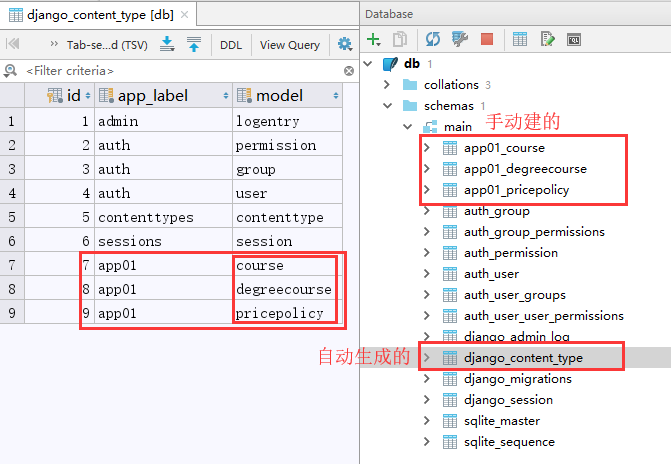Django-缓存机制、跨域请求(CORS)、ContentType组件
Django缓存机制:
在settings中间件里面设置:
三个粒度: 1 全站缓存 用中间件: MIDDLEWARE = [ # 'django.middleware.cache.UpdateCacheMiddleware', #起始位置配置:类似response,当请求完成返回时在这里往缓存存数据 'django.middleware.security.SecurityMiddleware', ...... # 'django.middleware.cache.FetchFromCacheMiddleware' #类似request,当请求过来时先经过其他中间件的一些操作(例如认证等),在最后这里从缓存取数据
]
# CACHE_MIDDLEWARE_SECONDS=10
2.单视图:
用装饰器
from django.views.decorators.cache import cache_page
# @cache_page(24*60*60)
3 局部页面设置(实现test有缓存机制,下面的ctime没有缓存机制):
{% load cache %}
{% cache 5 'test' %} 两个参数:时间(5秒内),唯一标识
{{ ctime }} {% endcache %}
跨域请求(CORS):
要实现的效果就是:我在本地上的域名是127.0.0.1:8000,请求另外一个域名:127.0.0.1:8001一段数据
正常情况,浏览器上就会报错,个就是同源策略的保护,如果浏览器对javascript没有同源策略的保护,那么一些重要的机密网站将会很危险
简单请求与非简单请求区别:
只要同时满足以下两大条件,就属于简单请求。凡是不同时满足上面两个条件,就属于非简单请求。
(1) 请求方法是以下三种方法之一: HEAD GET POST (2)HTTP的头信息不超出以下几种字段: Accept Accept-Language Content-Language Last-Event-ID Content-Type:只限于三个值application/x-www-form-urlencoded、multipart/form-data、text/plain
如何处理:
浏览器的同源策略解决方法
2 简单请求:发一次请求
response['Access-Control-Allow-Origin'] = '*'
response['Access-Control-Allow-Origin'] = 'http://127.0.0.1:8008,http://127.0.0.1:8009'
2 非简单请求:发两次,一次预检(OPTIONS),第二次是真正的请求
if request.method=='OPTIONS':
response['Access-Control-Allow-Methods']='PUT,DELETE'
response['Access-Control-Allow-Headers']='Content-Type'
建议写再中间件里
注释:里面尽量不要写(*),都支持(*)
ContentType组件:
表格关系的介绍:价格表与专题课表和学位课表关联,2张表里分别有各自分类的课程,价格统一维护在价格策略表里面
解决什么问题:表的id和数据id,来唯一确定一条数据
主要的一些设置信息:
插入数据:
models:content_obj = GenericForeignKey('table_id', 'course_id')
存:models.PricePolicy.objects.create(period=5, price=18000, content_obj=degree)
查询数据:
1 通过课程查价格策略:
policy = GenericRelation('PricePolicy', object_id_field='course_id', content_type_field='table_id')
course.policy.all() 拿出所有价格策略
2 通过价格策略查课程
content_obj = GenericForeignKey('table_id', 'course_id')
price.content_obj 拿到的就是课程对象
代码案例如下:
首先要先导入:
from django.contrib.contenttypes.models import ContentType from django.contrib.contenttypes.fields import GenericForeignKey,GenericRelation
ContentType其实内部就是一个表格
#由来
#settings里面的
INSTALLED_APPS = [
'django.contrib.admin',
'django.contrib.auth',
'django.contrib.contenttypes',
'django.contrib.sessions',
'django.contrib.messages',
'django.contrib.staticfiles',
'app01.apps.App01Config',
]
#看源码ContentType的表格,封装的有字段(这些字段就是在生成数据的时候自动建立的表格)
@python_2_unicode_compatible
class ContentType(models.Model):
app_label = models.CharField(max_length=100)
model = models.CharField(_('python model class name'), max_length=100)
objects = ContentTypeManager()
即自动Django数据库里自动生成的数据表

专题课表:Course
#专题课表 class Course(models.Model): title=models.CharField(max_length=32) # 固定到哪个门课,不会再数据库中生成字段,进而可以只用来查询对应的价格,例如使用就是Couser.policy=价格信息对象.price拿到所对应的价格信息 policy=GenericRelation('PricePolicy',object_id_field='course_id',content_type_field='table_id')
学位课表DeggreCourse:
#学位课表 class DegreeCourse(models.Model): title=models.CharField(max_length=32) policy=GenericRelation('PricePolicy',object_id_field='course_id',content_type_field='table_id')
价格策略表:
#价格策略表 class PricePolicy(models.Model): #课程周期 period=models.IntegerField() #课程价格 price=models.PositiveIntegerField() #具体哪一门课程id course_id=models.PositiveIntegerField(null=True) #对应哪个课程表的id,只不过用forenkey做了外键关联(与导入的ContentType表的id做关联即可以看到id分别对应是那张表# ) table_id=models.ForeignKey(to=ContentType,null=True) #7,8吗 # 将通过table_id-course_id做关联,得到一条数据对象,会自动将课程id与表格id进行绑定 content_obj=GenericForeignKey('table_id','course_id')
views视图设置:
from django.shortcuts import render,HttpResponse # Create your views here. from app01 import models def addPrice(reqest): #为Python运维开发专题课,添加三个价格策略 #方式一:普通方式添加(比较复杂每次都要取出课程、取出表) #第一步:拿到专题课表里面id=1Python运维开发对象、已经对应表格对象(只有这2个条件才能确定一条准确的数据-表的对应关系) #拿到课程表对象 course=models.Course.objects.filter(id=1).first() # #拿到专题课表的表格对象:去ContentType这张表里找到course对应的id table=models.ContentType.objects.filter(model='course').first() #根据课程找到对应的表对象 # # table = models.ContentType.objects.filter(model=course.__class__.__name__.lower()).first() #根据专题课程名小写拿到专题课表对象 # #第二步:插入数据 # # #增加数据(注意点1:table_id只是个字段,存在数据库后会自动再加上一个id,所以就写成table_id_id) models.PricePolicy.objects.create(period=1,price=0,course_id=course.id,table_id_id=table.id) '''数据库中:价格策略表的显示结果 id period price course_id table_id_id 1 1 0 1 7 ''' #为学位课里面的id=2的智能机器人课程添加一条价格策略 #为只能机器人学位课,加一个价格策略 degree=models.DegreeCourse.objects.filter(id=2).first() models.PricePolicy.objects.create(period=3,price=10000,content_obj=degree) #因为degree里面也有id,也有表名 # print(degree.__class__.__name__) #DegreeCourse 内部其实一定做了这个可以拿到表名 print(degree.policy.all()) #拿到的是整个价格策略表里面每条数据的对象 for i in degree.policy.all(): print(i.price) #遍历出每条数据再.price可以取出对应的字段属性值 return HttpResponse('ok')





